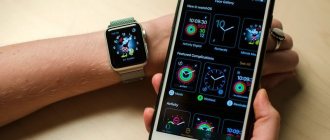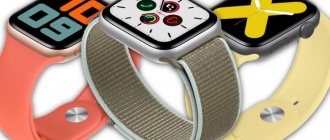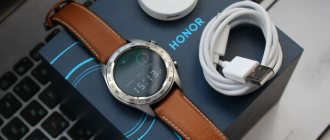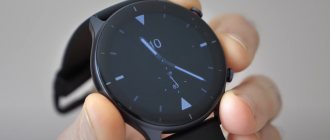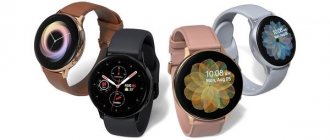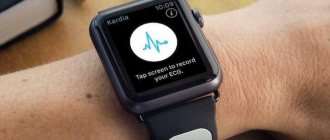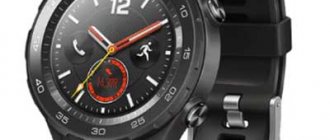Gear S3 is a new generation of smartwatches from Samsung. The South Korean company has developed two versions of the Gear S3: the more aggressive Frontier for outdoor activities and the more expensive Classic for beauty. Both versions of the watch run on Samsung's proprietary Tizen operating system and are equipped with a rotating bezel.
The devices also combine: built-in GPS to monitor sports training and send emergency SOS messages; speaker for making calls; “Samsung Pay” function to pay for purchases through the watch; and a more capacious battery.
Samsung has done a lot of work on the design and features of the Gear S3. We tested this smartwatch for two weeks to determine whether Apple, Google and other companies should be wary of competition from the Gear S3.
Specifications
- Screen: 1.3″, IPS Super AMOLED, 16 million colors, 360×360 pixels, capacitive, 392 ppi;
- Operating system: Tizen 2.3.2;
- Processor: Exynos 7270, 1 GHz;
- RAM: 750 MB;
- Built-in memory: 4 GB;
- Battery: Li-Ion 380 mAh;
- Dimensions: 49 x 46 x 12.9 mm;
- Weight: 59 g (Classic), 63 g (Frontier);
- Communication: WIFI: 802.11 b/g/n 2.4 GHz, NFC, Bluetooth 4.2 (A2DP, AVRCP, HFP, HSP), GPS/GLONASS;
- Sensors: accelerometer, gyroscope, heart rate sensor, barometer, light sensor;
- Available versions: Classic, Frontier.
OS
The Tizen operating system is still in place, new products appear in the application store with enviable consistency.
For example, the Lifesum application for counting calories, which I have been using for several years, is supported by the Tizen platform. Well, such useful things as Uber and similar programs are also available here.
The watch has acquired the long-awaited GPS receiver, accelerometer, gyroscope and barometer. In terms of the number of bells and whistles, this is the most sophisticated watch. There is also a heart rate sensor, which adds the function of a fitness bracelet to the watch, a very expensive fitness bracelet.
Equipment
The watch is supplied in a cylindrical box made of thick matte black cardboard. The design of the lid is made in the form of a now popular technique - relief concentric circles. The company and model names are embossed. Depending on the version, the color of the top edge varies.
Unpacking is the main ritual after purchase, on which the first impression of the type of device depends. The Samsung Gear S3 is straightforward in this regard. You lift the top part of the “cylinder” - and there the watch lies beautifully on a stand for wireless charging, and the inscription “Samsung” is engraved, like the signature of the author. As they say, “you just have to extend your hand and they are yours.”
The above is placed on a plastic platform (the entire inner surface of the box is made of plastic), under which there are a user manual and a warranty card, in which everything is written in a tiny font; to read it, you need to strain your eyes, as well as a 5V 0.7A charger with a wire 1 meter long, which connects to a magnetic stand via a microUSB connector.
Autonomy
The capacity of the built-in battery pack is 380 mAh. The indicator may not be the highest, but it is enough for the gadget to fully function for several days. With active system loading, the period may decrease to approximately 1.5-2 days. In standby mode, this period can last for days and weeks. The manufacturer has done an excellent job in this direction and undoubtedly deserves sincere praise and gratitude.
Charging is carried out via wireless technology. The corresponding module is included in the delivery kit. As a pleasant addition, there is an LED sensor that signals the charging status and battery full level.
Appearance and features
The overall appearance of both versions of the Gear S3 is relatively similar, with a stainless steel composite body held together by four screws. A metal bezel rotates around the 1.3-inch display, making it easy to navigate through the interface. The watch has a standard 22 mm strap mount - this expands the possibilities for customizing the appearance, limiting only the variety of straps available.
The lower part is identical in both cases and contains an optical heart rate monitor with two LEDs, inscriptions indicating the model name, country of manufacture - Vietnam, and CE marking.
On the right side of the watch there are two buttons: “back” and “home”, next to the second there is a microphone.
On the other side there are three small speaker holes.
External differences concern the front part. Starting from the color (black for Frontier and silver chrome for Classic) and the shape of the buttons, to the material of the strap (genuine leather for Classic and silicone for Frontier), as well as weight - the weight of the watch officially indicated by the manufacturer is 59 and 63 g for Classic and Frontier respectively, but due to the straps the weight increases to 72 and 87 g, which is already more noticeably felt during direct use.
Samsung Gear S3 is protected according to the IP68 standard, which means complete protection from dust and moisture, as well as immersion in fresh water up to one and a half meters for 30 minutes, however, the manufacturer notes on the official website and in the quick start instructions that swimming, showering and exercising Diving in them is prohibited. On the contrary, a consultant at the official Samsung store assured that you can swim in them safely. It is worth noting that the warranty does not cover damage caused by disruption or interruption of operation of the device due to flooding.
Unfortunately, in practice we were not able to test their water resistance, since someone opened the samples before us and did not tighten the screws completely, we decided not to risk it.
The Gear S3 Frontier also differs from the Classic in that it can withstand extreme temperature changes.
Regarding shock resistance, it is assumed that the steel case should withstand an ordinary drop from a height of one and a half meters (a typical height when putting a watch on the wrist), and the protruding bezel should protect the screen from direct physical impact. The display itself is protected from scratches and can withstand accidental contact even with metal objects such as a subway handrail or a car door.
Despite the same price for both versions, Frontier looks more expensive than Classic. It seems that the Classic was created as an addition to the "core" Frontier. Perhaps it’s the “whale” strap; on the Classic it looks rustic, poor, and not at all elegant, while on the Frontier it only adds even more brutality.
Frontier is very difficult to put on due to the thick silicone strap, which does not slip at all, but it is wider and fits snugly on the hand, and also better withstands diving, temperature changes and other extreme situations. Classics, on the contrary, are aimed at calm behavior of the “wearer”; with classic analogue dials, they look like ordinary wristwatches, which is why the user will be able to surprise “unenlightened” friends by raising his hand to see the time, and then twist the bezel to check the weather, notifications, find out the latest news, or even answer a call or write an SMS.
Frontier or Classic
Classic offers a design that is as close as possible to the appearance of conventional watch models. The vintage feel is perfectly complemented by a leather strap. This combination makes the accessory almost indistinguishable from the classics beloved by many.
Frontier looks downright impressive. The contoured bezel is supplemented with special marks. This makes the device even more attractive. A stylish and modern silicone-based strap completes the picture.
The difference between the models is insignificant. Frontier offers greater ergonomic shape and improved button comfort. And the bezel looks more attractive. Classic has a more strict form factor, which practically cannot leave anyone indifferent. He is able to optimally complement the image of a business person and harmoniously fit into the style he professes.
Frontier copes well with sudden temperature changes and fluctuations. Such smartwatches weigh only a few grams more than their counterparts. The main difference lies in the hardware. Frontier has an integrated LTE module, and
Classic can only boast of Bluetooth and Wi-Fi. Compliance with MIL-STD 810G ensures Frontier performs productively and trouble-free even under the most extreme conditions.
Display
What makes the Samsung Gear S3 look like a watch is its 1.3-inch (32.9 mm) round screen, equipped with an IPS Super AMOLED matrix with a resolution of 360x360 pixels, the density of which is 392 ppi. The clarity of the image is colossal, even the smallest symbols of the additional dials are visible without graininess.
The degree of brightness change is measured in 10 points, but the adaptive adjustment function depending on the lighting eliminates the problem of constant adjustment.
Color rendition is at the highest level, viewing angles are as wide as the maximum angle possible when looking at the watch.
The screen is covered with a layer of scratch-resistant glass and has an oleophobic coating.
The Always-on-display feature, as the name suggests, instead of turning off the screen, reduces the backlight level to a minimum so that the user does not have to shake his hand to activate the clock and see the time.
Iron
Samsung has equipped the Gear S3 with a dual-core ARM Cortex-A53 1 GHz Exynos 7270 processor, built on a 14 nm process technology that provides lower power consumption and improved performance (The Gear S2 uses Exynos 3250, 28 nm, ARM Cortex-A7, 1 GHz).
Apps and watch faces installed on watches do not require as many resources as, for example, smartphones, so 750 MB of RAM (500 MB in Gear S2) is enough to quickly switch between elements of the Tizen OS interface.
Of the 4 GB of internal memory, only 1.6 GB is available to the user. They can be used as a storage for installed applications, images both sent to the Gear, and screenshots of the watch itself, as well as music tracks for playback by the built-in player through the watch’s speaker or a Bluetooth headset connected to it.
On the back of the Gear S3 there is an optical heart rate sensor that reads very clearly, accurately repeating the rhythm of the heartbeat during the measurement process.
For lovers of hiking (especially mountain hiking), the Samsung Gear S3 has a built-in barometer and altimeter. The first measures pressure in hectopascals (hPa) and inches of mercury (inHg), and also shows a graph of further pressure changes based on data for the last 6 hours. If we convert hPa to mmHg. and compare with a regular home barometer, the difference in readings is minimal.
Altimeter (altimeter) is a device for measuring the altitude of an object’s “flight” based on GPS data.
The Samsung Gear S3 has a built-in NFC module for using the Samsung Pay service.
The watch can work either in tandem with a smartphone or as an independent device; to do this, you need to activate the Offline mode, which breaks the Bluetooth connection with the smartphone and all functions such as answering calls, showing notifications, receiving messages, etc. Uses the built-in Wi-Fi module to install applications and watch faces, and Bluetooth to connect wireless headphones. This mode is intended primarily for training without a smartphone.
Fitness
Traditionally, fitness has many functions. These include activity tracking, stair climb counting, a heart rate monitor that monitors your condition every 15 minutes, and even GPS. Separately, it is worth noting the barometer and altimeter, which will not be useful to everyone, but will definitely find their connoisseur.
If you play any sport with gloves on or just walk down the street on a cool day, then a mode is provided for this that increases the sensitivity of the screen, thereby allowing you to use it without taking off your gloves. Of course, this will not always work, and if you have gloves comparable in appearance to welder’s gloves, then nothing will work, but in some situations it will definitely be more convenient.
Software
Samsung Gear S3 runs on an open operating system platform based on the Linux kernel - Tizen 2.3.2, adapted for the watch shell.
The public today debates especially actively about the benefits and functionality of smart watches, because the wearable electronics market is “blooming”, new players are appearing, and competition is growing.
Some say that this is a useless waste of money, and those who confirm the benefits are divided into two “camps” - the first put sports functions at the forefront (pedometer, altimeter, heart rate monitor with appropriate software, etc.), and the second believe that it is not the functionality that is important, but the design and, first of all, convenience, which manifests itself in the fact that the watch allows you to constantly stay up to date with events, and not waste energy every time taking your phone out of your pocket (new notifications, instant reading and replying to messages , weather check, BT headset functions, etc.), and fitness functions are perceived only as an addition.
Samsung Gear S3 may well reconcile the controversial supporters of smart watches, as it perfectly combines functions that will suit everyone.
To connect the Gear S3 to a smartphone and configure some programs, you need to install the Gear S application, available on Google Play and AppStore; the features and nuances of how the application works with iOS and Android will be discussed below.
Dial - where you can add widgets and switch between them on the right side, and to the left of the dial you can scroll through new notifications.
Pressing the home button opens a list of installed applications. They are also arranged in a circle. Some pre-installed applications are aimed at quick access to smartphone functions:
- Phone - opens a list of recent calls, contacts, and also allows you to dial any number and call directly from the watch.
- Contacts - allows you to select a contact (search) and call or send SMS directly from the watch. There are 4 types of input available to choose from: keyboard, dictation, drawing, emoticons.
- Weather - updates weather data for cities selected in the Gear S app via your smartphone and displays the information on the watch screen.
- Music - combines the function of controlling music playback on a smartphone and a full-fledged mp3 player. Selected tracks are transferred to the watch's internal memory via the Gear S app on your smartphone.
- S Voice is a voice assistant similar to Siri, capable of many things - from calling a contact or phone number, to viewing weather data, getting directions and searching for places. Displays information on the screen of a watch or smartphone.
- Organizer applications: Reminders, Calendar, World clock, Alarm clock.
- Flipboard News Briefing is a short, up-to-date news digest.
- Find Phone is a useful utility that triggers a beep on your smartphone. Helps to find it not only if it goes missing in an apartment or house, but also if it is stolen or lost.
Samsung claims there are over 10,000 apps available in the Galaxy Apps store - which doesn't seem to be true. Besides the huge number of watch faces (including paid ones), most of which were developed during the Gear S2 era, the applications that are suitable for installation on the Gear S3 mainly belong to the “health and fitness” group, or these are utilities from industry giants, like Yandex with a metro map and traffic jams.
Tizen OS
The operating system is an important part of any smartwatch. Apple is carefully developing watchOS, Google has temporarily postponed the release of a major update to Android Wear 2.0, Pebble is also finalizing its own OS.
What about Tizen? In the Gear S3, Samsung installed proprietary OS version 2.3.1. System controls on the Gear S3 remain largely unchanged. From the main screen there is quick access to the main settings: brightness, music player, battery status (swipe down), recent activity, application notifications (right), calendar reminders, fitness data (left). Tap directly on the screen to choose a watch face style. The selection isn't as rich as the Apple Watch, but the collection of styles is pretty decent. Pressing the bottom physical button opens a neat circular interface where you can use the bezel to scroll through app icons.
In general, Tizen is a fast, simple and easy-to-manage OS. The interface provides a menu of recent applications, just like on a phone; it is possible to arrange application icons in your own way or delete unnecessary programs. You can add widgets, create shortcuts to applications or data from S Health.
The notification support is also nice. True, the Gear S3 has problems with displaying pictures in notifications, but in general SMS, mail and other notifications are conveniently grouped. Plus, there are tons of ways to control them, like twisting the bezel to rewind your notifications.
Samsung has packed a lot into the Gear S3, so you'll need to spend some time exploring and finding the modes and features that suit you. Either way, you don't have to worry about anything because Tizen itself is a really simple operating system that you can understand as you go. It lacks the contextual features of Android Wear and some of the beloved elements of the Series 2, but Samsung has built a ton of cool features into its watch OS.
S Health
S Health is an application developed by Samsung to track the activity of the owner of the Gear S3 watch (or Gear Fit bracelet). First, you need to download the application from Google Play, then create or log into an existing Samsung account, and then indicate your physical data and activity level.
The watch app counts steps, calories, floors (based on altimeter data), regularly measures heart rate, monitors activity, reminds you to warm up every hour, and recognizes sleep time. You can keep track of the amount of water and coffee you drink,
S Health is a great training assistant. The database contains 16 types of exercises, each of which has a specific set of monitored activities. So, for example, while riding a bicycle, the watch will count speed, calories, distance and heart rate.
The smartphone program has a wide range of functions. The main goal is to maintain statistics, not only based on data from the Gear S3, but also by manually entering data. Using the program, you can control the number of calories consumed by choosing a dish - you can search through restaurant menus! You can also monitor your weight, blood sugar, blood pressure, etc.
The “Goals” mode will clearly show the progress of achieving the desired level of activity, nutrition, and sleep.
In the “Together” tab, you can compare your results with all S Health users, or with your age group, or you can add friends and arrange a competition.
Working with Android
It’s no secret, and it’s obvious that this watch will work flawlessly with Samsung smartphones, including instant connection, fast content sharing and the Samsung Pay function (but this is not certain, we haven’t tested it). The manufacturer also promises stable operation (or explains how to eliminate the shortcomings as much as possible) on the page of the global website with a list of devices compatible with the watches being reviewed, therefore, in order to answer the question about the interaction of the Gear S3 with any interpretation of Android OS, we chose the hero as a “guinea pig” recent review, Chinese Umi Max.
A pleasant surprise was that after installing the Samsung Gear application, as well as the two plug-ins required for operation, all functions except Samsung Pay work as they should. The connection was easy and quick, applications downloaded and updated reliably.
Despite the fact that our device is far from Samsung, S Health works to the maximum.
A couple of times there was an unexpected break in the watch-smartphone pair and to restore the connection I had to reboot the watch.
Working with iOS
In the last quarter of 2016, a beta version of the Gear S application based on iOS began to circulate on the Internet for connection with the Gear S2 and S3 smart watches and the Gear Fit fitness bracelet. Then, to install this application, you had to do several manipulations in the iPhone settings. On January 7, 2022, this application became available for download in the Russian AppStore. Its rating is unimportant, although there are not enough reviews, which suggests that there are quite a few perverted individuals who are ready to “connect the incompatible.”
The first contact between iPhone and Gear S3 is the most difficult and patient task. To connect to the phone, the device uses two Bluetooth channels: Bluetooth LE (Low Energy - a standard with lower energy consumption) to maintain the connection and management functions such as sending messages, reading notifications, controlling music, etc., and to use the watch as a Bluetooth headset , that is, for conversations using the built-in speaker and microphone, a standard Bluetooth channel is used.
You cannot close the application. It should always be running at least in the background.
The connection is quite fast, but downloading, installing and updating applications takes a very long time. So long that this may not happen at all. It is better to install applications one at a time, maximum two at a time, otherwise you will have to restart everything and get rid of installation errors that constantly pop up.
The release version of the Gear S app is not far from the beta version. While using it to write a review, there were permanent freezes, lags, and disconnections. Many features, such as sending images from your watch to your phone, are not available.
S Health for iOS does not exist, it is included in the Gear S. Available measurements: steps, floors, water, caffeine, sleep, heart rate and 4 activities: walking, running, cycling, hiking.
Unfortunately, with the release of the tenth version of iOS, which contains many additional features, in particular the effects of sent messages and stickers that will not be displayed in notifications, the point in buying the Gear S3 disappears, and the brand itself seems to oblige you to buy an Apple Watch, despite its price . If you remove the heart rate monitor and altimeter with barometer, the benefits from the Gear S3 for iPhone are as much as from Chinese clones of popular smartwatches for 2000 rubles.
When did the first smart watches appear?
The first watches that could do more than just show time were released back in the mid-eighties of the last century. First separately by Seiko, and later in collaboration with Epson. The line was labeled RC, and the characteristics of the devices were ridiculous by today's standards, but absolutely fantastic for that time. For example, the RC-20, released in 1985, was equipped with an 8-bit processor, 8 KB of internal memory and 2 KB of RAM. The display had a resolution of 42 by 32 pixels. They were loaded with scheduling apps, notes, a world clock, and a calculator. The watch could be connected to a computer for programming. Most popular computers of the time were supported, such as the Apple II, IBM PC, NEC 8201 and others.
At the turn of the two millennia, an attempt was made to make another watch that was ahead of its time. In June 2000, IBM introduced the world to a prototype wristwatch running on Linux. The watch had an accelerometer, vibration motor and even a fingerprint sensor. Citizen was chosen as a partner and was ready to collaborate with IBM to create the WatchPad. It was assumed that the model would be equipped with a display with a resolution of 320 by 240 pixels and run on Linux 2.4. The watch also had to have a built-in calendar, Bluetooth, 8 MB of RAM and 16 MB of internal memory. The WatchPad was supposed to cost only $399, but for a number of reasons the project was canceled two years later.
So things went sluggishly with smartwatches until in 2012 Pebble presented its vision of such an accessory on Kickstarter, and the media increasingly began to feed the market with rumors about the imminent appearance of the iWatch, as they were called then. Here, as they say, “here we go.” All manufacturers began to produce their own versions of this device. Moreover, technology has already made it possible to do something truly worthwhile.
Design was difficult early on, and few could come up with something interesting that didn't seem like a Tamagotchi toy on a strap. There were, of course, exceptions in the form of the Motorola Moto 360, but this was rare. Even the appearance of the cute curved Samsung Gear S didn't help the situation much.
Then they were replaced by the Samsung gear S2, which looked more like a classic watch, and on August 31, 2016, the newest Gear S3 was officially presented, one of the nice features of which is decent compatibility not only with Android devices, but even with the iPhone.
Battery
Samsung Gear S3 is equipped with a lithium-ion battery with a capacity of 380 mAh, which is 130 mAh more than the Gear S2. Charging is carried out by connecting to a magnetic stand and there is no other method provided. Samsung promises fast charging, but in fact the watch charges up to 50% in 2 hours, and fully in 4 hours.
After fully charging and immediately pairing it with the smartphone at 17:00 on the first day, without disconnecting the connection and taking into account that 70% of the time the watch and phone were just lying on the table, sometimes social network notifications came in - so the charge lasted for 70 hours.
Those who want to get the most out of their watch, that is, use it for training, for talking, monitoring sleep, constantly receiving and responding to notifications, messages, and all this with always-on GPS and the Always-on-display function, can expect an average of one and a half days of battery life.
To (emergency) save battery power, the Gear S3 has a power-saving mode that switches the home screen theme to grayscale, disables all functions except calls, messages and notifications, disables Wi-Fi, and limits maximum performance. In this mode, the watch can work up to 5 hours on the remaining 10%.
Payment service Samsung Pay
This smartwatch also has NFC, which provides an alternative way to connect to the Gear IconX headphones, and most importantly, activates the Samsung Pay service for paying for purchases and services through the watch. To set up Samsung Pay, you need to verify your bank card. This can be done via SMS or by calling the bank. Please note that verification must be carried out separately for both the phone and the Gear S3. Therefore, if you call the bank, make sure that both devices are confirmed.
Then you need to set a PIN code on your watch. Here again there will be a problem due to the fact that the Gear S3 is inconvenient to type on. After several attempts to enter the code correctly, it is saved and is no longer requested unless you remove the smartwatch. Then all you have to do is hold down the top button to turn on Samsung Pay and bring the Gear S3 to the terminal.
The advantage of the Samsung Pay service in the Gear S3 is that now you don’t need a Samsung phone. The company has decided to open this platform to almost all Android phones. There is an official list of compatible devices, but it is not accurate enough, since for example the LG V20 is not on the list, but we managed to connect it to the Gear S3 and set up Samsung Pay in the standard way. Although, this service is temporarily unavailable in the UK, so if you live there, be patient.
Also, the advantage of Samsung Pay compared to Apple Pay is that it can be used with magnetic terminals. Of course, this will require a little practice to learn how to make the necessary wrist manipulations.
The expansion of Samsung Pay to most Android phones is very bad news for Android Pay, which has yet to launch on Android Wear OS. Google seems to be lagging behind Samsung.
